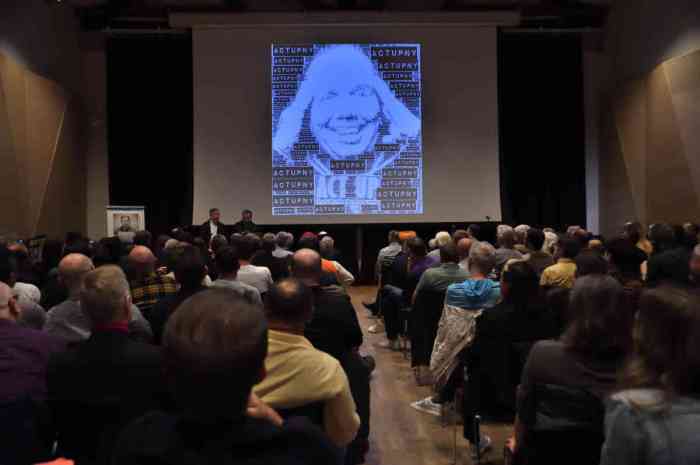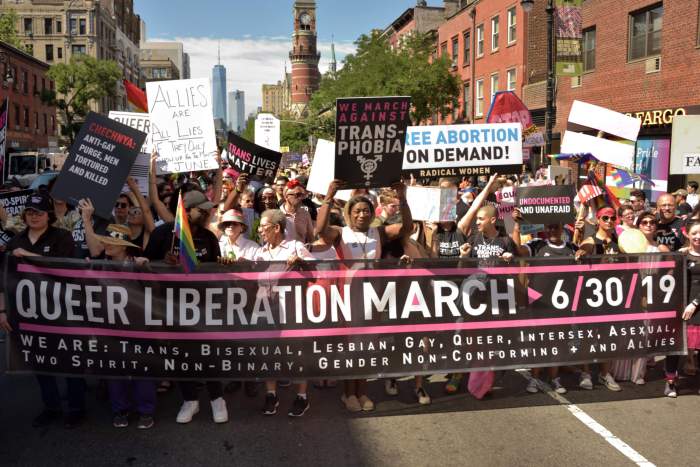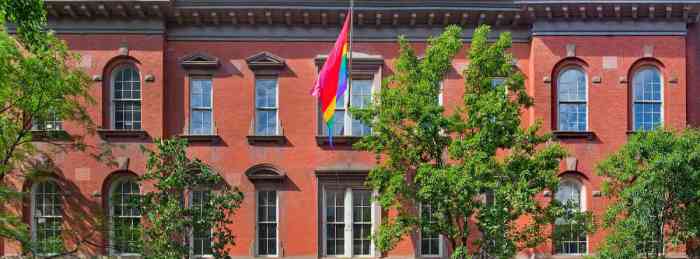Gilbert Baker helps carry his Rainbow Flag within the Gays Against Guns contingent in the 2016 Pride March in Manhattan in commemoration of those killed and injured in the Orlando Pulse nightclub massacre earlier that month. | DONNA ACETO
Gay pioneer and artist Gilbert Baker, who died in his sleep at age 65 on March 31 at his home in Manhattan, did not just create the iconic Rainbow Flag but he gave it away freely to the world where it was embraced in every corner — from its origins in San Francisco to Russia and Uganda and Kathmandu — as the universal symbol of LGBTQ liberation and the diversity that characterizes our community.
Gilbert’s untimely death – due to a heart attack – came as a shock to his many friends, fellow activists, and admirers and reverberated around the world as his creation did and always will.
Gilbert was not just the Betsy Ross of the community who sewed the flag and versions of it small to massive, but one of the community’s foremost front-line revolutionaries who made and carried protest banners for actions protesting the homophobia of Vladimir Putin, the once exclusionary St. Patrick’s Day Parade, and Donald Trump — to name just a few targets in recent years.
Queer Nation holds up a Baker banner demanding more comprehensive federal civil rights legislation than the Employment Non-Discrimination Act outside the 2014 City Council Pride Celebration, a year ahead of the introduction of the Equality Act. | DONNA ACETO
Duncan Osborne, a comrade of Gilbert’s in Queer Nation, said, “He created a global movement by giving us a common symbol. You see the Rainbow Flag around the world and it has a common meaning.” At Queer Nation actions, Osborne said, “we would get a banner from him and suddenly a group of 20 people would look like a hundred. You can walk past a few people holding posters, but a 60-foot banner you couldn’t ignore. His contribution was extraordinary and done with a simple tool that you would normally look at and say, ‘What’s that going to do?’”
The answer was always that Gilbert’s work made these actions pop — and he was almost invariably on hand to unfurl his banners and to join in holding them up.
Gilbert’s Rainbow Flag was the only flag ever to have been acquired by the Museum of Modern Art, which first displayed it in 2015. Immediately after the debacle of the 2016 election, MoMA moved it to their grand entrance hall to wave over visitors and welcome them all.
When the anti-LGBTQ Vice-President-Elect Mike Pence moved to a suburban Washington neighborhood during the transition last fall, many of his new neighbors tried to send him a signal of who they were by festooning their houses with Rainbow Flags.
Gilbert’s Rainbow Flag has been projected on iconic buildings from the Empire State to the Eiffel Tower in celebration of LGBTQ pride.
The Gays Against Guns contingent in last year's Pride March. | DONNA ACETO
President Barack Obama lit up the White House in rainbow colors on the evening of June 26, 2015, when marriage equality triumphed at the Supreme Court. And Donald Trump, who has surrounded himself with anti-LGBTQ activists and is gutting LGBTQ rights, appropriated one to hold up at a campaign rally in a deceptive effort to soften his reactionary image. The flag is also flown by merchants around the world to signal that they are LGBTQ-friendly — or at least want the business of LGBTQ people and our allies.
When the 25th anniversary of the Stonewall Rebellion was marked in New York in 1994, Gilbert stitched together a rainbow flag that was literally a mile long to mark the occasion monumentally. It took 5,000 people to carry it up First Avenue past the United Nations. For the 2003 Key West Pride Parade – the year the Rainbow Flag was 25 years old – he exceeded his own record for “world’s longest flag” by making one that extended across that resort town from the Atlantic Ocean to the Gulf of Mexico.
At the time of his death, he was active in the preparations for Stonewall 50 in 2019.
A vigil was held in Gilbert’s memory on Friday, the day of his death, in San Francisco’s Harvey Milk Plaza where Gilbert’s huge Rainbow Flag has flown for 20 years on a 70-foot pole. Gilbert never wanted the Rainbow Flag to fly at half-staff – even for himself. (Gilbert submitted a similarly tall display of his flag in a design competition for a memorial in Hudson River Park to those who were victims of the 2016 Orlando Pulse massacre and other hate crimes. The decision of Governor Andrew Cuomo’s Task Force on that memorial’s design has yet to be announced.)
Gays Against Guns protesting across the street from Trump Tower before last year's election. | DONNA ACETO
Gilbert first created an eight-color Rainbow Flag (including hot pink and turquoise in addition to the six primary and secondary colors) in San Francisco in 1978 in those heady days when Harvey Milk had been elected the town’s first out gay supervisor. (In November of that year, Milk was assassinated at City Hall along with Mayor George Moscone, by former Supervisor Dan White.) Gilbert’s activist friend Cleve Jones, an aide to Milk, helped him dye the fabric.
“I knew right away this was the most important thing I would ever do,” Gilbert said in 2013.
Gilbert said he got the idea in 1976 during the US bicentennial.
“American flags were on everything,” he recalled. “It gave me the idea that we could have a flag because even though we’re not a nation, we’re a people.”
“Flags are torn from the soul of the people,” Gilbert said in 2007.
“That day when he raised the first Rainbow Flag [to fly over City Hall on Gay Freedom Day], he knew that was his life’s work,” Jones told the San Francisco Chronicle. “And for every march, every protest, every celebration, every memorial, he was always sewing and sewing and sewing. For generations to come, people will know that flag. It’s an example of how one person can have an amazing and brilliant idea that reaches not just millions, but hundreds of millions of people.”
Gilbert Baker, at center in black shirt, holds up a banner at the vigil outside Stonewall the day after the Orlando massacre. | DONNA ACETO
Gilbert never “patented” his flag design and it remains in the public domain, as all flags apparently do. He wanted the world to have it and was active in its promotion. At World Pride in Rome in 2000, he mounted his first exhibition of photographs and fine art celebrating his flag.
Gilbert’s longtime friend Charley Beal, a gay activist who was also art director on the film “Milk,” said, “Gilbert just finished 39 nine-color Rainbow Flags adding the color lavender for diversity for the 39th anniversary of the Rainbow Flag to be shown at a gallery in San Francisco during Pride Month. He got up and made art every day. He was relentless. He put all his passion in the stitches. One of his greatest accomplishments was when he unfurled the mile-long flag in 1994. He cut the flag into large pieces that were given to delegations from Pride organizations around the world and within a year those pieces were showing up at Pride celebrations from Brazil to China to Cuba — in effect internationalizing the flag as a symbol of the LGBT community. It was a seminal moment for our community.”
The fabulous Gilbert Baker in last year's Pride March. | DONNA ACETO
Richard Ferrara, another close friend, said, “In 1985, Heritage of Pride brought the Rainbow Flag from San Francisco to New York. There were not Rainbow Flags here before that. I was the merchandizing chairperson for HOP for two years starting in 1986 promoting the flag and our Keith Haring logo.”
Matt Foreman, then with HOP, said, “We just embraced it instead of the Christopher Street West version with the lambda in the upper left corner.”
“I lived, slept, and breathed that flag,” Ferrara said.
He first met Gilbert at the UN press conference announcing the mile-long flag for Stonewall 25 in ’94, and they became close friends.
“We spoke twice a day and there was never a conversation where he didn’t end it by saying, ‘I love you,’” Ferrara recalled.
In 2013, when Queer Nation was protesting the awarding of the Sochi Olympics to the anti-LGBTQ regime of Putin, the group picketed outside a conference on US-Russian trade at the Princeton Club in Manhattan with a Gilbert-created big “PUSSY POWER” banner that incorporated tiger stripes – highlighting Princeton’s mascot – and drew attention to Putin’s repression of the radical women’s band Pussy Riot. Lesbian activist Ann Northrop, Gilbert’s friend, borrowed the banner and paraded it with friends through Manhattan during the Women’s March on January 21, hanging it from the overpass on 42nd Street at Grand Central Terminal to the cheers and delight of hundreds of thousands protesting President “Grab-’em-by-the-Pussy.”
“Gilbert’s death is a huge and shocking loss for me and all who knew and loved him, and to the whole LGBT community,” Northrop, my co-host on “Gay USA” said, praising him for “his vision and generosity. He never copyrighted the flag or made a penny off it, and he lived very simply. He loved calling himself a seamstress who spent his days slaving over a sewing machine. His enormous, beautiful, cheeky banners were a crucial element in the success of Queer Nation actions in the last few years, increasing our impact geometrically.”
Gilbert gave a tremendous boost to the 25-year protest against the exclusion of Irish LGBTQ groups from the St. Patrick’s Day Parade in New York. While hundreds protested the exclusion of the Irish Lesbian and Gay Organization in the 1990s, he supported the smaller continuing protest of Irish Queers in 2014 with a “BOYCOTT HOMOPHOBIA” banner that took up half a city block and delivered a message to all who disrespected the boycott. It was held aloft by a larger group in 2015 and the next year — for a variety of reasons — parade organizers relented and allowed the LGBTQ group Lavender and Green to participate under their own banner.
Gilbert Baker's Pussy Power banner hangs over the Grand Central viaduct during New York City's Women's March on January 21.
Gilbert showed up to New York’s 2002 Pride Parade as Betsy Ross and made it a point to march right next to the new, buttoned-down Mayor Mike Bloomberg, adding a note of liberation to the mayor’s more sober contingent and attracting numerous press photographers. He always knew what he wanted the picture to be and made it happen with his visual artistry. He wasn’t about attracting attention to himself, but to the cause.
Gilbert was born in Chanute, Kansas, on June 2, 1951, his father a judge and his mom a teacher. He served in the Army from 1970 to 1972 and was honorably discharged, an account of which he described to the late Randy Shilts for his 1993 book about gays in the military, “Conduct Unbecoming.” Like many gay veterans before him who passed through or were stationed in San Francisco, Baker settled there.
In the 2016 Pride March, Gays Against Guns protesters take on the Republicans. | DONNA ACETO
“I went from being a pretty dumb kid in Kansas growing up in the ‘50s and all of the bomb scare and Eisenhower and everything very Republican and always feeling outcast… to a place of liberation in San Francisco at the very moment gay rights was exploding,” he said in 2013.
Gilbert taught himself how to sew and was commissioned to create flags for visiting dignitaries and, at the behest of his friend Harvey Milk, banners for anti-war and gay rights demonstrations.
Gilbert Baker at the 2016 opening of Congregation Beit Simchat Torah's new home in Chelsea. | DONNA ACETO
Gilbert was an artist and a philosopher in his creation of the flag in ‘78, assigning meanings to each of its original eight colors: hot pink for sexuality, red for life, orange for healing, yellow for sunlight, green for nature, turquoise for magic and art, blue for serenity and harmony, and violet for spirit. The number of stripes and colors changed over the years, but never its overall call for LGBTQ liberation and inclusion.
Irish gay and AIDS activist Father Bernárd Lynch, who with Gilbert’s “beloved friend Richard Ferrara” co-signed the authenticity of the Stonewall 25 flag for the Guinness Book of World Records — wrote, “Gilbert, through your Rainbow Flag you gave the world a New Covenant of Love, Peace, Freedom & Joy. We are forever in your debt.”
Gilbert was a featured character in Dustin Lance Black’s dramatization of Cleve Jones’s memoir “When We Rise” on ABC-TV, a recent four-part saga of the history of LGBTQ liberation in San Francisco. When I saw Gilbert on the street just two weeks ago, he talked about how he was happy with his portrayal by Dylan Arnold when he was young and Jack Plotnik when he was older, but he was also full of dish about how he had to intervene at one point about what the Gilbert character was wearing because it wasn’t him — it wasn’t “fabulous” enough.
“Anyone can be an activist,” Gilbert told Radio Free Europe/Radio Liberty in a 2013 interview, “but it’s not easy… You have to be free yourself, you have to have your own core values, and you have to have some courage and some steel, and that’s really hard for a lot of people. They can’t come out because of their family situation. To whatever degree that people can be first of all honest with themselves, that’s the beginning of being an activist, it’s knowing who you are. You bet it’s dangerous, and that’s why it takes a lot of love… You can’t do it by yourself. You have to build bridges, you have to have a loving environment, loving friends, people that you trust and support to work together to achieve it. I don’t think individuals are able to achieve as much as the mass.”
Gilbert Baker with President Barack Obama at the 2016 White House Pride Celebration. | COURTESY: JAY BLOTCHER
Gilbert is survived by his mother, Patricia Baker of Conroe, Texas, and sister, Ardonna Baker Cook of Cypress, Texas, and a worldwide LGBTQ community inspired by him and his work.
In a written statement, Baker and Cook said,“He will be dearly missed by his family, friends, the art world, as well as the entire LGBTQ community. He led a bold and inspiring life by bringing the Rainbow Flag to the world and teaching others about the beauty in diversity. We are working alongside Gilbert’s friends and the community to plan a public memorial service in the near future.”
We’re all less fabulous without Gilbert. There are not too many people in our movement who are indispensable. Gilbert was surely one.
Inside St. Paul’s Cathedral in London, the epitaph to its great architect Sir Christopher Wren says, “Reader, if you seek his memorial — look around you.” No one has to look far to see the memorial to the great artist and activist Gilbert Baker. It flies everywhere LGBTQ people seek to be free.











































